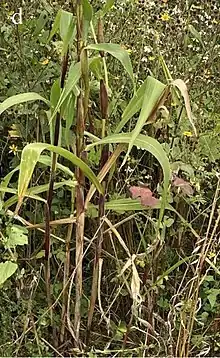Zea perennis
Zea perennis, the perennial teosinte,[3] is a true grass species in the genus Zea and a teosinte.
| Zea perennis | |
|---|---|
 | |
| Scientific classification | |
| Kingdom: | Plantae |
| Clade: | Tracheophytes |
| Clade: | Angiosperms |
| Clade: | Monocots |
| Clade: | Commelinids |
| Order: | Poales |
| Family: | Poaceae |
| Subfamily: | Panicoideae |
| Genus: | Zea |
| Species: | Z. perennis |
| Binomial name | |
| Zea perennis | |
Taxonomy
It is one of the two perennial species in the genus Zea. The other perennial, Z. diploperennis, is the sister taxon of Z. perennis. Those two species also form a clade with Z. luxurians. Together, the three species make up the Luxuriantes section in the genus Zea.[4] Z. perennis is the sole tetraploid in the genus and fertile hybrids with diploid Zea species are rare. Ribosomal ITS evidence suggested introgression between Z. perennis and Z. mays that must have come from either crossing the ploidy barrier or been from the diploid ancestral pool. Z. perennis is generally considered to be an autotetraploid from some ancestral population of Z. diploperennis.[5]
Agriculture
Due to the economic importance of maize, significant scientific interest exists in using the genes of the other Zea species for crop improvement. Z. perennis is of particular interest because of the potential for maize to become a perennial crop. However, difficulty in using genes from Z. perennis in Z. mays mays for crop improvement has occurred because the genes used often contain unwanted teosinte traits. Z. perennis is tropical and not winter hardy, which has led to problems in using its genes to make a perennial form of maize.[6] To overcome this, breeding efforts have focused on deeper rhizomes that can survive below the frost line.[7]
References
- Sánchez, J.J., Ruíz Corral, J.A., de la Cruz Larios, L. & Contreras, A. 2019. Zea perennis. The IUCN Red List of Threatened Species 2019: e.T77727073A77727085. https://dx.doi.org/10.2305/IUCN.UK.2019-2.RLTS.T77727073A77727085.en. Accessed on 28 October 2022.
- "GRIN Species Records of Zea". Germplasm Resources Information Network. United States Department of Agriculture. Archived from the original on 2004-11-08. Retrieved 2010-11-06.
- USDA, NRCS (n.d.). "Zea perennis". The PLANTS Database (plants.usda.gov). Greensboro, North Carolina: National Plant Data Team. Retrieved 9 August 2015.
- Doebley, J. (1990). Molecular Systematics of Zea (Gramineae). Maydica, (35), 143–150.
- Buckler, E. S., & Holtsford, T. P. (1996). Zea systematics: ribosomal ITS evidence. Molecular biology and evolution, 13(4), 612–22.
- Jackson, W., & Kirschenmann, F. (2009). A 50-Year Farm Bill. The Land Institute.
- "Perennial Cereal Grains: A Promise Requiring Patience and Prioritization". Perennialsolutions.org. 17 April 2013. Retrieved 15 June 2019.
